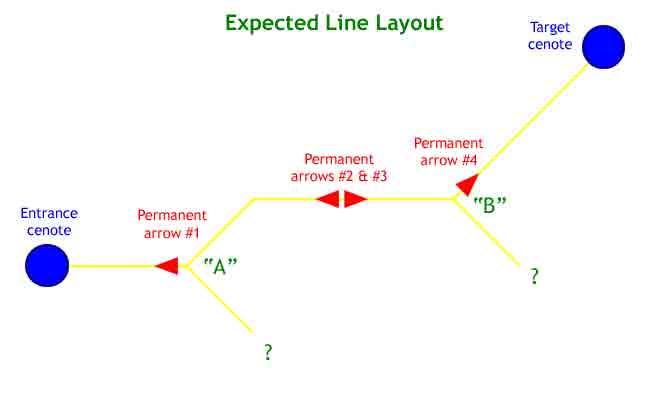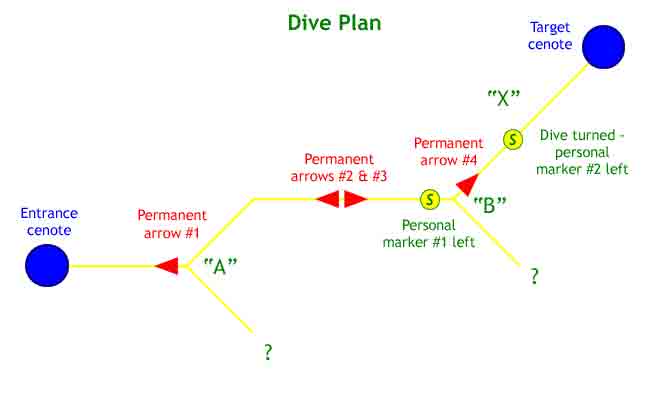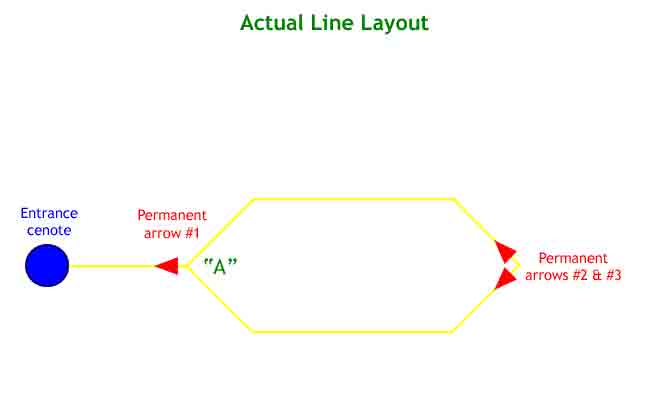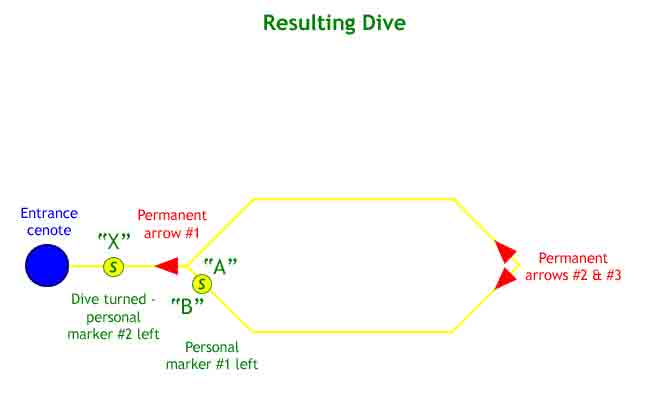
| Cave Formation | |||
| Training & Safety | |||
| Equipment | |||
| Projects | |||
| Papers | |||
| Photos | |||
| Video | |||
| Links | |||
| Contact Us | |||
The Conundrum:
1. A team of divers is planning to do a set-up for a future traverse between two cenotes. They have been told that the line layout is like this. Note that at the moment we are just interested in the setup dive, not what happens when they try the traverse.

2. They plan to mark their route like this. The key points are (1) they will turn left at each of the first two Ts they arrive at, (2) that they will leave a marker at the second T because the arrow will not be pointing towards their entrance, and (3) that they will leave a marker when they hit their turn pressure and turn the dive. Because this is a setup dive for a traverse from the second cenote, they will of course leave the two markers in place.

3. Either they have received bad information, or someone has changed the lines. The actual layout is like this.

4. No matter. They will follow the navigation rules taught to them on their cave course, and all will be fine. Their resulting dive looks like this.

Commentary
1. Nothing wrong with the dive plan.
2. Because of bad information, our divers have unknowingly made a big loop. When they think they are at the second T, they are actually back at the first T, but they do not know this. Embarrassing, but it happens.
3. They followed the rules going in. They did not leave a marker at the first T, because the permanent marker was already pointing to their entrance point. They left a marker at what they thought was the second T, because the permanent marker was not pointing to their entrance point. They placed a marker on the line before they turned. They left both markers in place, because they plan a traverse from the other cenote at a future date.
4. On the exit, they have a problem. When they first return to the T (which they think is the second T), they correctly retrace their steps by going right. They swim around the loop, and get to what they think should be the first T. The problem now occurs: the T has their personal marker on it pointing into the cave. Read the last sentence again. If they follow their personal marker, they will be lost.
What's the Point?
1. The divers might realise what they have done, or they might not. That's not the point.
2. The point is that this is an example of divers following the rules, but finding that as a result they have a personal marker leading them into the cave. This should not happen.
3. This is a simple case, and smart divers should realise their problem, either when they get to what they think is the first T and find the markings are not as they remembered them, or when they get to the double arrows the second time (hopefully they have enough breathing gas left ...). Nevertheless it is unsettling.
4. It is possible to construct more complex cases, particularly involving multiple Ts or jump lines, where the divers will not know when they go wrong. Read the last sentence again. This is very unsettling.
5. All of these cases have the same features in common: (1) the divers unknowingly return to a point they were previously; and (2) they leave their markers and/or jump lines in place on the exit.
Why does this happen?
1. The navigation system we use is "personal marker > double arrow > single arrow > nothing" (where ">" means takes priority over).
2. This system attributes information to an absence of a personal marker at a T (it implies that any line arrows point to out exit), and to the absence of a jump line on a straight shot of line (if there is a jump line there we take it).
3. By returning to a piece of our earlier route and placing a marker on it, we destroy this information. By leaving the markers when we exit, we change the significance when we loop back to this point. That's the problem.
4. There are several reasons we might leave our markers and jump lines in place. These include: (1) a setup for a traverse; (2) an emergency exit (e.g. no lights ...); (3) we plan to return to the same place for surveys, science experiments, or just to go further into the cave; and (4) we just miss a marker or jump reel when we exit.
How Likely is this?
1. No idea. But none of the examples are unusual. The Naharon to Mayan Blue traverse involves three jumps to the left. Novices or divers unfamiliar with the system could take almost any route from Mayan Blue A tunnel to B tunnel. In Sac Aktun it is possible to loop back on oneself in several places. Dos Ojos upstream has many circuits and loops ...
What's the Solution?
1. Don't know.
2. "Don't do traverses" doesn't work, because the problem could occur any time that markers or jump lines are left in place.
3. "Use a compass" is questionable, especially in zero vis or lights out ...
4. Ditto "Number each marker and jump reel", for the same reason ...
5. I think we solve the problem on Ts by marking every T we come to with a personal marker, regardless of the orientation of the permanent arrows.
6. The problem with a jump line is that it takes priority over a straight line. Logically we need to mark each jump line with a personal marker and remove the marker when we exit, even in an emergency. This seems complicated ...
7. Ideas welcome ...
Other Examples
Simon Richards, July 28, 2003
